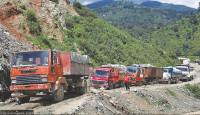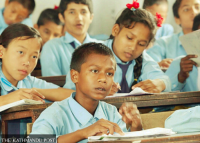Opinion
Poor people, rich parties
Given that political parties are labelled as the most corrupt institutions all over the world, regulating political party finances has become a matter of concern and discussion in global politics.
Given that political parties are labelled as the most corrupt institutions all over the world, regulating political party finances has become a matter of concern and discussion in global politics. This applies to Nepal as well. We are on the verge of looking at the possibility of state financing of political parties. So far, when it comes to political party finances, we have focused on campaign financing, which looks at expenditure during elections instead of showing concern for transparency and disclosure of political financing.
Recently, based on the submission of income and expenditure statements by the political parties registered with the Election Commission (EC), a broadsheet daily published the financial data of 83 political parties for 2015-16. At the time of publication, there were a total of 112 political parties registered with the EC. Nearly, one-fourth of them failed to submit their financial statements. The disclosure requirement is still not a priority for the political parties.
Information from 83 political parties is a substantial sample size from which meaningful generalisations can be made. After all, something is better than nothing. The table alongside presents the submitted financial information of the top 20 political parties based on their income, expenditure and surplus/deficit situation for 2015-16.
Domination of the big three
The Nepali Congress, the CPN-UML, and the CPN (Maoist Centre) dominate the political landscape as the three major parties. This is evident in the nature of distribution of political power in Nepal, the number of seats in Parliament and the share of votes in the last elections. No other political parties match their level. While smaller parties look like minions, the big three parties look like sharks. The big three share 68 percent of the total income of the 83 political parties.
The CPN-UML is at the top with 31 percent, followed by the Nepali Congress with 25 percent and the Maoist Centre with 12 percent. One can understand the UML’s arrogance. They have the money and they can organise mass rallies and demonstrations like the recently concluded Mechi-Mahakali campaign. Unlike the other two big parties, they are also adept at producing a surplus. They saved Rs25 million, while the NC had extremely Rs29 million and the Maoists Rs2.6 million. Based on financial poalsower, the UML is the largest party. Remember, in politics it is not only the votes, but the notes that are counted—literally and figuratively. If we designate the UML as the rich party of poor people, the NC demonstrates itself as a weak party of elites. Can we call the NC a poor party of rich people? If the NC cannot manage party financing, how is it going to manage the national coffers? In the 1990s, we used to call the Rastriya Prajatantra Party (RPP) the party of the aristocrats. In these republican days, they come nowhere close to the big three.
Newbies and rich communists
It is interesting to see two newcomers on the list: Bibeksheel Nepali and Nepal Pariwar Dal. In terms of revenue generation, they hold the fifth and eighth positions respectively. Knowing their sources of financing could prove insightful. In the next elections, given their money power, they could pose a formidable challenge to the traditional political parties. I suggest that Dr Baburam Bhattarai and Mr Rabindra Mishra learn a lesson or two from the party financing of Bibeksheel Nepali and Nepal Pariwar Dal.
Among the top 20, six political parties are labelled as communist parties. There are many other smaller parties tilting towards the left. So Nepal must be a poor country with rich communist leaders. The simple and thrifty Mr Chitra Bahadur KC is hidden behind the affluence of his political party, the Rastriya Jana Morcha. His party is at the ninth position. If we consider the order of rankings, we can understand the arrogance of certain leaders from smaller parties. CP Mainali, Bijaya Gachhedar and Narayan Man Bijukchhe are examples of such arrogant leadership. Clearly, it is the power of money that speaks louder in Nepali politics.
Scepticism versus hope
The financial statements also reveal five broad categories of political parties. These include: Nepali Congress party, the communist parties, the monarchists, the Terai- and ethnicity-based parties, and the newcomers who see themselves as alternative forces.
One interesting finding from the data is that our political leaders are better at spending money than making it. Nepali Congress President Sher Bahadur Deuba can claim a trophy for a record deficit of Rs29 million. As indicated in the bottom row of the table, there is a total deficit of Rs5.8 million. Could this be an indirect justification for state subsidy? Out of 83 political parties, only six have submitted statements with equal income and expenditure. There is one party that goes by the name of Nepal Communist Party (Samajbadi) that is not shown on the list; this party has all expenditure and no income.
The publication of financial statements, howsoever unreliable they may be, is definitely a step in the right direction. This will put political parties in the limelight for further public inquiry and investigation. But given the figures disclosed—particularly considering the tendency to disclose more expenditure than income—there is greater room for scepticism than for hope about the improvement in political party financing in Nepal.
- Manandhar is a freelance consultant




 17.12°C Kathmandu
17.12°C Kathmandu









